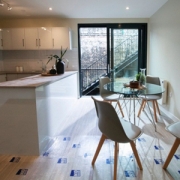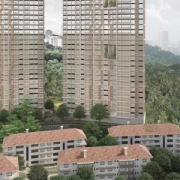The homes can be assembled and furnished in a week. Picture: LDRS
Super-speedy flat pack homes installed in Mile End for homeless families
#flatpackhomes #homeless #socialhousing #londoncouncil
Two prototype modular homes have been put up in Mile End by the Pan-London Accommodation Collaborative Enterprise (PLACE) to provide temporary accommodation for families in need.
If the first test models are successful, Tower Hamlets Council hopes to get planning permission to build 16 on the site of some old garages in Landon Walk, Poplar.
The homes would be designed to stay in place for 10 years, the council said.
John Biggs, mayor of Tower Hamlets, said: “It could make a real difference to how we accommodate homeless Londoners at a time when our city is experiencing an ongoing housing crisis.
“I am glad we’ve been able to host these test units in Tower Hamlets. We’ve already identified a site for the first modular homes and in the coming weeks we hope to secure planning permission. It’s important that we think outside the box to tackle these complex challenges and this programme is doing just that.”
PLACE, which was started by London Councils that represents 32 boroughs, said the accommodation has the quality of permanent housing but the units can be relocated to a different site if required.
The homes, supported by £11 million of funding from the Mayor of London, will be put on land earmarked for development in the long term, which would otherwise remain underused.
There are some 2,000 homeless families in Tower Hamlets and more than 60,000 households in the capital currently live in temporary accommodation.
London Council’s is looking suitable locations for the flat pack homes and PLACE aims to supply 200 of the models across the capital by February 2022.
Tom Copley, London’s deputy mayor for housing & residential development, said: “PLACE shows what can be done when City Hall, councils and innovative construction and tech industries work together to tackle one of our city’s most pressing issues.
“Homeless people and those living in temporary accommodation deserve high-quality homes. This project will not only help improve the housing available for homeless families and reduce the cost of providing temporary accommodation for local authorities, but will hopefully drive innovation in house building, showing the potential of precision-manufactured housing.”
Source: East London Advertiser



